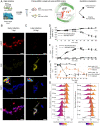Visualizing active viral infection reveals diverse cell fates in synchronized algal bloom demise
- PMID: 33707211
- PMCID: PMC7980383
- DOI: 10.1073/pnas.2021586118
Visualizing active viral infection reveals diverse cell fates in synchronized algal bloom demise
Erratum in
-
Correction for Vincent et al., Visualizing active viral infection reveals diverse cell fates in synchronized algal bloom demise.Proc Natl Acad Sci U S A. 2021 Jun 29;118(26):e2110243118. doi: 10.1073/pnas.2110243118. Proc Natl Acad Sci U S A. 2021. PMID: 34155123 Free PMC article. No abstract available.
Expression of concern in
-
Editorial Expression of Concern: Visualizing active viral infection reveals diverse cell fates in synchronized algal bloom demise.Proc Natl Acad Sci U S A. 2021 Apr 13;118(15):e2105198118. doi: 10.1073/pnas.2105198118. Proc Natl Acad Sci U S A. 2021. PMID: 33827931 Free PMC article. No abstract available.
Abstract
Marine viruses are the most abundant biological entity in the ocean and are considered as major evolutionary drivers of microbial life [C. A. Suttle, Nat. Rev. Microbiol. 5, 801-812 (2007)]. Yet, we lack quantitative approaches to assess their impact on the marine ecosystem. Here, we provide quantification of active viral infection in the bloom forming single-celled phytoplankton Emiliania huxleyi infected by the large virus EhV, using high-throughput single-molecule messenger RNA in situ hybridization (smFISH) of both virus and host transcripts. In natural samples, viral infection reached only 25% of the population despite synchronized bloom demise exposing the coexistence of infected and noninfected subpopulations. We prove that photosynthetically active cells chronically release viral particles through nonlytic infection and that viral-induced cell lysis can occur without viral release, thus challenging major assumptions regarding the life cycle of giant viruses. We could also assess active infection in cell aggregates linking viral infection and carbon export to the deep ocean [C. P. Laber et al., Nat. Microbiol. 3, 537-547 (2018)] and suggest a potential host defense strategy by enrichment of infected cells in sinking aggregates. Our approach can be applied to diverse marine microbial systems, opening a mechanistic dimension to the study of biotic interactions in the ocean.
Keywords: algal blooms; giant virus; single cell; smFISH; viral life cycle.
Copyright © 2021 the Author(s). Published by PNAS.
Conflict of interest statement
The authors declare no competing interest.
Figures




References
-
- Azam F., Microbial control of oceanic carbon flux: The plot thickens. Science 280, 694–696 (1998).
-
- Suttle C. A., Marine viruses: Major players in the global ecosystem. Nat. Rev. Microbiol. 5, 801–812 (2007). - PubMed
-
- Laber C. P., et al. ., Coccolithovirus facilitation of carbon export in the North Atlantic. Nat. Microbiol. 3, 537–547 (2018). - PubMed
-
- Fenchel T., Marine plankton food chains introduction: The classical view of plankton food chains. Annu. Rev. Ecol. Syst. 19, 19–38 (1988).
-
- Field C. B., Behrenfeld M. J., Randerson J. T., Falkowski P., Primary production of the biosphere: Integrating terrestrial and oceanic components. Science 281, 237–240 (1998). - PubMed
Publication types
MeSH terms
Substances
Associated data
LinkOut - more resources
Full Text Sources
Other Literature Sources

